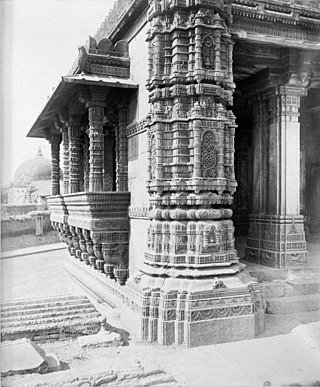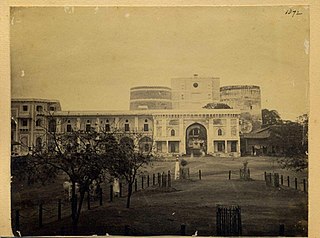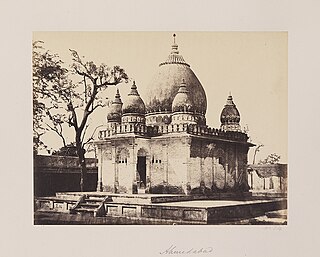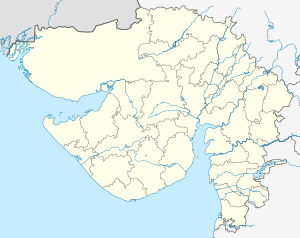
Mirza Shahab-ud-Din Muhammad Khurram, also known as Shah Jahan I, was the fifth Mughal emperor, reigning from 1628 until 1658. During his reign, the Mughals reached the peak of their architectural and cultural achievements.

Ahmedabad is the most populous city in the Indian state of Gujarat. It is the administrative headquarters of the Ahmedabad district and the seat of the Gujarat High Court. Ahmedabad's population of 5,570,585 makes it the fifth-most populous city in India, and the encompassing urban agglomeration population estimated at 6,357,693 is the seventh-most populous in India. Ahmedabad is located near the banks of the Sabarmati River, 25 km (16 mi) from the capital of Gujarat, Gandhinagar, also known as its twin city.

Indo-Islamic architecture is the architecture of the Indian subcontinent produced by and for Islamic patrons and purposes. Despite an initial Arab presence in Sindh, the development of Indo-Islamic architecture began in earnest with the establishment of Delhi as the capital of the Ghurid dynasty in 1193. Succeeding the Ghurids was the Delhi Sultanate, a series of Central Asian dynasties that consolidated much of North India, and later the Mughal Empire by the 15th century. Both of these dynasties introduced Islamic architecture and art styles from West Asia into the Indian subcontinent.

Mazar-e-Quaid, also known as Jinnah Mausoleum or the National Mausoleum, is the final resting place of Muhammad Ali Jinnah, the founder of Pakistan. Designed in a 1960s modernist style, it was completed in 1971, and is an iconic symbol of Karachi as well as one of the most popular tourist sites in the city. The mausoleum complex also contains the tomb of Jinnah's sister, Māder-e Millat Fatima Jinnah, as well as those of Liaquat Ali Khan and Nurul Amin, the first and eighth Prime Ministers of Pakistan respectively. The tomb of Sardar Abdur Rab Nishtar, a stalwart of the Muslim League from Peshawar, is also located there.

The Sidi Saiyyed Mosque, popularly known as Sidi Saiyyid ni Jali locally, built in 1572–73 AD, is one of the most famous mosques of Ahmedabad, a city in the state of Gujarat, India. The mosque was built by Sidi Sayyad, a Habshi nobleman, in 1572–73.
Sarkhej is a suburban neighbourhood in the city of Ahmedabad. It is primarily known for the Sarkhej Roza, an architectural complex located 8 km south from the city centre. One of the most important roads of metropolitan Ahmedabad, Sarkhej–Gandhinagar Highway, originates from Sarkhej and ends at the twin city Gandhinagar.
Mohammad Azam Khan is an Indian politician, lawyer and elected representative who has served as the Member of Parliament from Rampur. He is one of the founding members of the Samajwadi Party and was a member of the Seventeenth Legislative Assembly of Uttar Pradesh. He was also the senior most Cabinet Minister in the Government of Uttar Pradesh and has been elected member of the legislative assembly ten times from Rampur assembly constituency. He was disqualified from his elected seat when he received a two-year prison sentence from the court.

Mir Shihab-ud-Din Siddiqi, known by his title Ghaziuddin Khan, was a leading military general and noble of Central Asian origin in the Mughal Empire. He was a favoured member of emperor Aurangzeb's court, and the father of Chin Qilich Khan, founder of Hyderabad State. Under Aurangzeb, he distinguished himself in key battles over the Deccan, and held the governorship of Berar Subah. He briefly served as the governor of Mughal Gujarat during the reign of Aurangzeb's successor Bahadur Shah, and died in office. He is buried in a madrasa complex he founded during his lifetime, known as Madrasa Ghaziuddin Khan, which is located in Old Delhi.

Sarkhej Roza is a mosque and tomb complex located in the village of Makarba, 7 km south-west of Ahmedabad in Gujarat state, India.

Rani Sipri's Mosque also known as Rani Sipri ni Masjid or Masjid-e-nagina, formerly known as Rani Asni's Mosque, is a medieval mosque in the walled city of Ahmedabad, Gujarat in India. This mosque was commissioned in 1514 by Queen Sipri, the Hindu wife of Mahmud Begada, a sultan who ruled Gujarat. It is also known as Masjid-e-Nagina because of the intricate jali carvings on its walls. In 2006–7, the Ahmedabad Municipal Corporation proposed demolishing part of the monument in order to expand a road.

Bhadra Fort is situated in the walled city area of Ahmedabad, India. It was built by Ahmad Shah I in 1411. With its well carved royal palaces, mosques, gates and open spaces, it was renovated in 2014 by the Amdavad Municipal Corporation (AMC) and the Archaeological Survey of India (ASI) as a cultural centre for the city.

Saiyad Usman Mosque, alternatively spelled as Syed or Saiyyed, also known as Usmanpura Dargah or Roza or Saiyad Oosman Mausoleum, is a medieval tomb and mosque in Usmanpura, Ahmedabad, India.

Dariya Khan's Tomb or Darya Khan's Dome or Ghummat is a medieval brick tomb in Shahibaug, Ahmedabad, India.

Mir Abu Turab's Tomb, locally known as Qadam-e-Rasul ki Dargah is a medieval tomb in Behrampura, Ahmedabad, India.

Miya Khan Chishti's Mosque and Tomb is a medieval mosque and tomb complex on the bank of Sabarmati river in Shahibaug area of Ahmedabad, India.

Qutub-e-Alam's Mosque and Tomb, also known as Vatva Dargah is a medieval mosque and tomb complex in Vatva area of Ahmedabad, India.

Shah-e-Alam's Tomb and Mosque, also known as Rasulabad Dargah or Shah Alam no Rozo, is a medieval mosque and tomb complex (Roza) in Shah Alam area of Ahmedabad, India.

Sardar Khan's Roza or Nawab Sardar Khan's Mosque and Tomb, is a mosque and tomb complex in Jamalpur area of Ahmedabad, India.


















